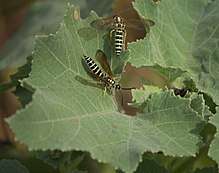Thynnidae
Thynnidae (also known as flower wasps) are a family of large solitary wasps whose larvae are almost universally parasitoids of various beetle larvae, especially those in the superfamily Scarabaeoidea. Until recently, the constituents of this family were classified in the family Tiphiidae, but multiple studies have independently confirmed that thynnids are a separate lineage.[1][2]
| Thynnidae | |
|---|---|
 | |
| Male Agriomyia sp. feeding on nectar | |
| Scientific classification | |
| Kingdom: | Animalia |
| Phylum: | Arthropoda |
| Class: | Insecta |
| Order: | Hymenoptera |
| Superfamily: | Thynnoidea |
| Family: | Thynnidae |
| Subfamilies | |
|
Anthoboscinae | |
Most species are small, but they can be up to 30 mm long. The females of some subfamilies (all Diamminae, Methochinae, and Thynninae) are wingless, and hunt ground-dwelling (fossorial) beetle larvae, or (in one species) mole crickets. The prey is paralysed with the female's sting and an egg is laid on it so the wasp larva has a ready supply of food. In species where both sexes are winged, males are similar in size to the females, but are much more slender. The males of species with wingless females, however, are often much larger than the females and have wings, the adults mating in the air, with the female carried by the male's genitalia. Adults feed on nectar and are minor pollinators. As some of the ground-dwelling scarab species attacked by thynnids are pests, some of these wasps are considered beneficial as biological control agents.


Genera
- Aelurus Klug, 1840
- Aeolothynnus Ashmead, 1903
- Agriomyia Guérin-Ménéville, 1838
- Ammodromus Guérin-Méneville, 1838
- Anthobosca Guérin-Ménéville, 1838
- Anthosila Genise, 1985
- Argenthynnus Genise, 1991
- Ariphron Kimsey, 2007
- Arthrothynnus Brown, 1996
- Aspidothynnus Turner, 1910
- Aulacothynnus Turner, 1910
- Austrotiphia Cockerell, 1906
- Belothynnus Turner, 1910
- Brethynnus Genise,, 1991
- Calchaquila Genise, 1985
- Callosila Saussure, 1892
- Campylothynnus Turner, 1910
- Catocheilus Guérin-Ménéville, 1842
- Chilothynnus Brown, 1996
- Chrysothynnus Turner, 1910
- Colobosila Sichel, 1864
- Cosila Guérin-Méneville, 1838
- Deuterothynnus Brown, 2010
- Diamma Westwood, 1835
- Dimorphoptera Smith, 1868
- Dimorphothynnus Turner, 1910
- Dolichothynnus Turner, 1910
- Doratithynnus Turner, 1910
- Dythynnus Kimsey, 2001
- Eirone Westwood, 1844
- Elaphroptera Guérin-Ménéville, 1838
- Elidothynnus Turner, 1910
- Epactiothynnus Turner, 1910
- Eucyrtothynnus Turner, 1910
- Glottynnus Genise, 1991
- Guerinius Ashmead, 1903
- Hathynnus Kimsey, 2003
- Heligmothynnus Brown, 2010
- Hemithynnus Ashmead, 1903
- Iswaroides Ashmead, 1899
- Lalapa Pate, 1947
- Leiothynnus Turner, 1910
- Lestricothynnus Turner, 1910
- Lophocheilus Guérin-Ménéville, 1842
- Macrothynnus Turner, 1908
- Meria Illiger, 1807
- Mesa Saussure, 1892
- Mesothynnus Kimsey, 1991
- Methocha Latreille, 1804
- Myzinum Latreille, 1803
- Neozeleboria Rohwer, 1910
- Odontothynnus Cameron, 1904
- Oncorhinothynnus Salter, 1954
- Phymatothynnus Turner, 1908
- Poecilotiphia Cameron, 1902
- Pogonothynnus Turner, 1910
- Psammothynnus Ashmead, 1903
- Pseudelaphroptera Ashmead, 1903
- Pterombrus Smith, 1869
- Rhagigaster Guérin-Ménéville, 1838
- Rhytidothynnus Brown, 2008
- Scotaena Klug, 1810
- Spilothynnus Ashmead, 1903
- Tachynoides Kimsey, 1996
- Tachynomyia Guérin-Ménéville, 1842
- Tachyphron Brown, 1995
- Takyomyia Kimsey, 2007
- Thynnoides Guérin-Ménéville, 1838
- Thynnoturneria Rohwer, 1910
- Thynnus Fabricius, 1775
- Tmesothynnus Turner, 1910
- Zaspilothynnus Ashmead, 1903
- Zeena Kimsey, 1991
- Zeleboria Saussure, 1867
References
- Pilgrim, E.; von Dohlen, C.; Pitts, J. (2008). "Molecular phylogenetics of Vespoidea indicate paraphyly of the superfamily and novel relationships of its component families and subfamilies". Zoologica Scripta. 37 (5): 539–560. doi:10.1111/j.1463-6409.2008.00340.x.
- Johnson, B.R.; et al. (2013). "Phylogenomics Resolves Evolutionary Relationships among Ants, Bees, and Wasps". Current Biology. 23 (20): 2058–2062. doi:10.1016/j.cub.2013.08.050. PMID 24094856.
External links
- Myzinum maculata Fabricius, a thynnid wasp on the UF / IFAS Featured Creatures Web site

- Debevec, Andrew H.; Cardinal, Sophie; Danforth, Bryan N. (2012). "Identifying the sister group to the bees: a molecular phylogeny of Aculeata with an emphasis on the superfamily Apoidea" (PDF). Zoologica Scripta. 41 (5): 527–535. doi:10.1111/j.1463-6409.2012.00549.x.